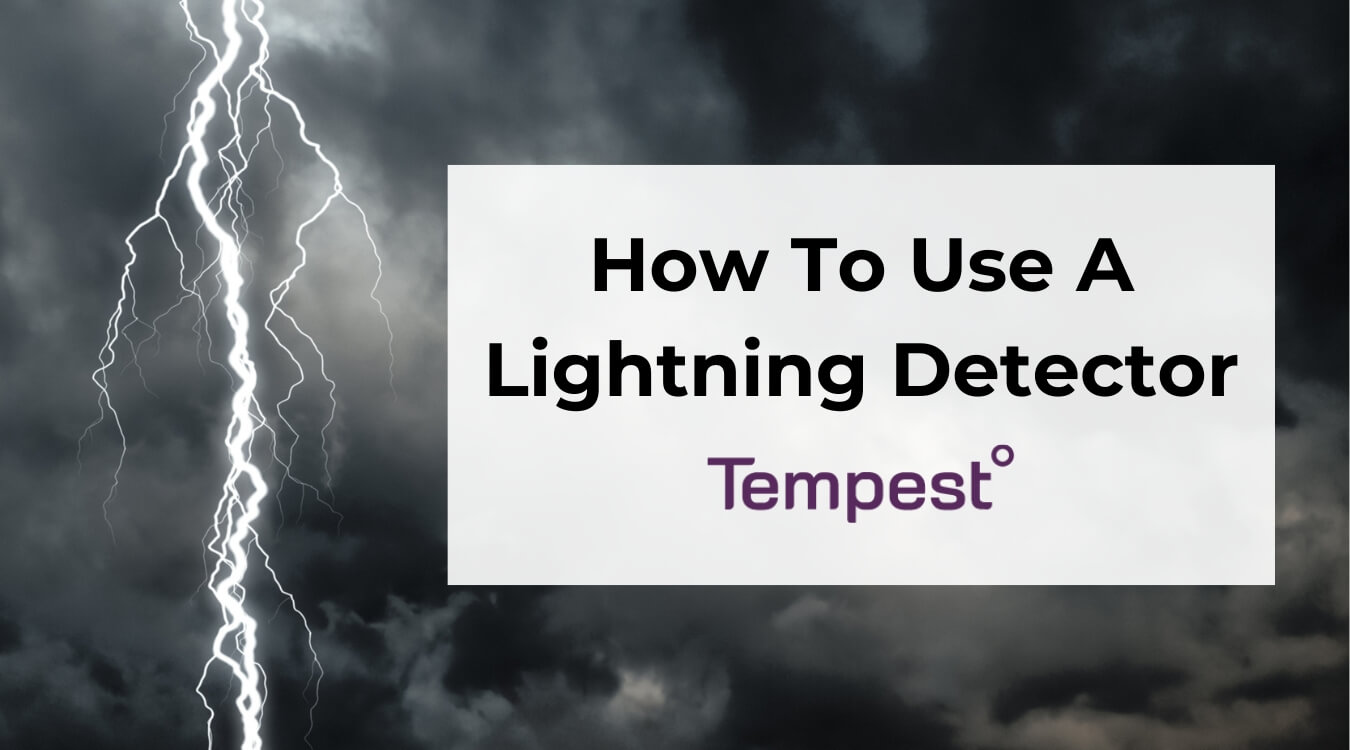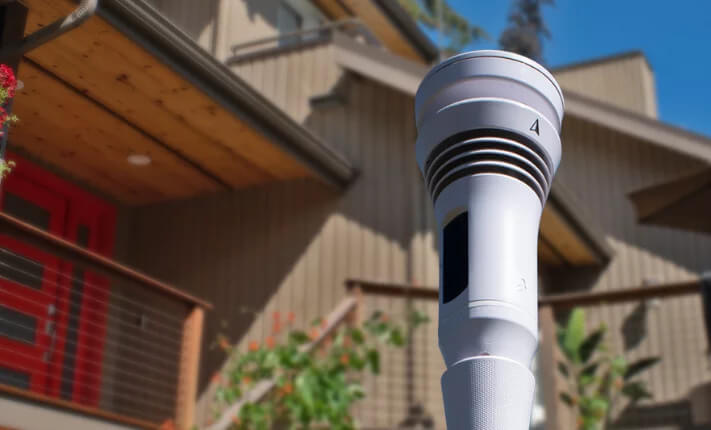
Meteorologists use lightning detectors to show where lightning strikes are occurring in an area. But how does a lightning detector work?
Lightning detectors are very accurate weather instruments measuring how far lightning strikes are from a location. If you don’t have a lightning detector or access to a weather radar during a storm, you can count the seconds between the lightning and thunder to tell how far the lightning is from you. Every five seconds between a lightning flash and the thunderclap equals about a mile.
Our guide covers what lightning detection is, how to use a lightning detector, and where to mount a personal one.
- What Is Lightning Detection?
- How Do Lightning Detectors Work?
- How To Use A Lightning Detector
- Where To Mount A Lightning Detector
Get the Tempest Weather System: An all-in-one personal weather station with a built-in lightning sensor.
What Is Lightning Detection?
How does lightning detection work? Lightning detection is the process of identifying where and when lightning occurs. There are two main types of lightning detection:
- Cloud-to-ground lightning detection: Tracks strikes that hit the earth’s surface.
- Intra-cloud lightning detection: Measures lightning activity within clouds.
While cloud-to-ground lightning strikes are the most commonly detected, some advanced lightning detection systems can also measure the strength and intensity of lightning strikes. These systems provide valuable data for meteorologists, emergency services, and industries that rely on real-time weather monitoring.
What Is A Lightning Detection Network?
A lightning detection network (LDN) is a system of sensors that work together to track and triangulate lightning strikes. There are two major lightning detection networks in the United States:
- The National Lightning Detection Network (NLDN): A network used by government agencies and private industries to detect and track cloud-to-ground lightning.
- The Earth Networks Total Lightning Network: A system that detects both cloud-to-ground and intra-cloud lightning, providing real-time storm tracking.
These networks use radio waves to accurately detect the location and intensity of lightning, helping industries like aviation, emergency response, and outdoor event planning make informed safety decisions.
How Do Lightning Detectors Work?
Lightning detectors operate by sensing high-frequency electromagnetic pulses created by lightning. When a lightning strike occurs, it generates a burst of radio waves that travel through the atmosphere.
The process of how a lightning tracker works is as follows:
- Sensors detect the electromagnetic waves produced by lightning.
- The detector’s system processes the data to determine the strike’s distance and intensity.
- An algorithm calculates the exact location based on triangulation (when using multiple sensors).
- The user receives real-time lightning alerts via a display screen or a connected weather app.
Some advanced ground-based lightning detectors, like the one built into the Tempest Weather System, can track lightning up to 40 km (25 miles) away. They also use third-party lightning data sources to improve accuracy and provide hyper-local lightning warnings.
How To Use A Lightning Detector
Using a lightning detector is simple, but the right type of detector depends on your needs. There are two common types of personal lightning detectors:
Personal Weather Station With A Built-In Lightning Detector
A personal weather station, like the Tempest Weather System, comes with an integrated lightning detector. This device continuously monitors for lightning activity and sends real-time alerts to your phone.
Why choose a weather station with a lightning detector?
- Comprehensive weather tracking: In addition to lightning detection, it measures temperature, wind speed, humidity, and more.
- Smart home integration: Connects with smart home systems to trigger safety alerts.
- Data-driven forecasts: Provides storm tracking beyond just lightning detection.
Handheld Lightning Detector
A handheld lightning detector is a portable device designed for outdoor use, camping, or sports events. These devices are easy to carry and work by picking up electromagnetic pulses from lightning.
Limitations of handheld detectors:
- They don’t show the direction of the lightning, only the estimated distance.
- They have a shorter range compared to larger weather stations.
- No additional weather data is provided.
Despite these limitations, handheld detectors are great for those who need quick lightning warnings while on the move.
Where To Mount A Lightning Detector
Proper placement of a lightning detector is crucial for accuracy. If you own a personal weather station with a lightning detector, here are the best locations to mount it:
- High, unobstructed areas: Mounting it on a fence, deck, or rooftop helps reduce interference.
- Away from large buildings or trees: Avoid areas where tall structures could block or distort radio waves.
- A location free from electrical interference: Keep the detector away from power lines, metal structures, or electronic equipment that could interfere with its readings.
For handheld lightning detectors, no mounting is needed. You simply turn them on and monitor conditions while outdoors.
Get Accurate Lightning Detection With The Tempest Weather System
How do lightning trackers work? Lightning trackers detect electromagnetic pulses from lightning strikes to calculate how far the lightning is from a specific location. These detectors are essential for storm tracking, aviation safety, and outdoor event planning.
The Tempest Weather System is an advanced personal weather station equipped with a built-in lightning detector. It detects lightning strikes up to 40 km away and uses third-party lightning data sources to enhance accuracy. It also sends real-time lightning alerts directly to your phone and works alongside other weather-tracking tools like wind, humidity, and barometric pressure sensors.
The Tempest Weather System offers one of the most accurate personal weather solutions. Get one today!

